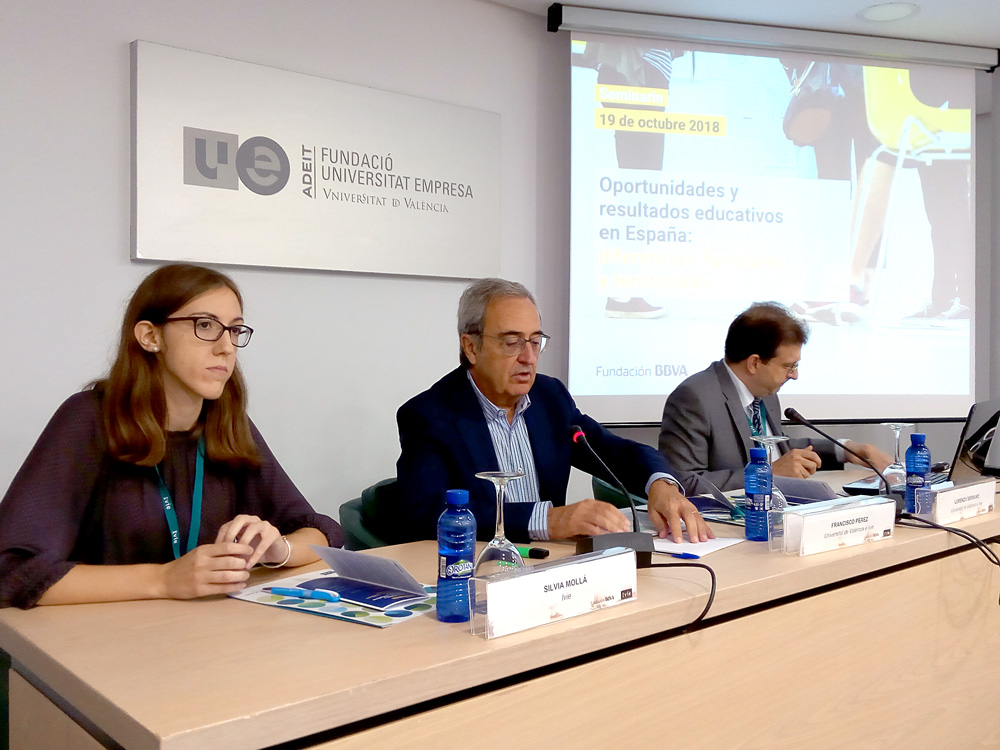Esta web utiliza cookies para que podamos ofrecerte la mejor experiencia de usuario posible. La información de las cookies se almacena en tu navegador y realiza funciones tales como reconocerte cuando vuelves a nuestra web o ayudar a nuestro equipo a comprender qué secciones de la web encuentras más interesantes y útiles.
News

The Valencian educational system stands out for equality but is weak in aspects such as access to pre-school education and high drop-out rates
Public expenditure on education in the Valencian Community is 1.9% above the national average
Public spending on education per student across the Spanish regions varies greatly, ranging from a maximum expenditure of 7,320 euros in 2016 in the Basque Country to 4,496 euros in Madrid. The Valencian Community sits slightly above the average with spending of 5,436 euros per student, 1.9% higher than the national average (5,335 euros).
The above-average expenditure on education in the Valencian Community contrasts with the fact that this region’s total public revenue is the lowest of all the Spanish regions (2,404 euros per inhabitant, 16.9% below the national average of 2,893 euros).
With below-average GDP and public revenue per inhabitant, the Valencian Community, compared to other Spanish regions, has fewer public resources to support education as well as a less favorable socioeconomic environment. However, in terms of educational access, equity and results, it is in an intermediate position compared to the rest of Spain, according to results presented at the seminar “Educational opportunities and results: household and regional differences” organized by the Ivie and the BBVA Foundation in Valencia.
The OECD PISA results show that the Valencian Community’s scores in science (494 points) are similar to the national and OECD average (493 points), while the percentage of students performing poorly in science is 15.8%, lower than the national average of 18.3%. In addition, a number of indicators in the Ivie and BBVA Foundation report on regional differences in education (“Diferencias educativas regionals 2000-2016. Condicionanates y resultados”) reveal that the Valencian regional education system is more equal than in the rest of Spain, as it ensures that socioeconomic conditions influence educational results to a lesser extent than in other regions. As one example, while the difference, at 37 points, in science scores for schools in the Valencian Community whose students come from more favorable versus less favorable environments is significant, it is less than the average national difference of 67 points.
However, the Valencian Community has less favorable indicators than the rest of Spain in aspects such as pre-school enrollment (28.7% vs. 33.6%), high achievers in science (4.1% vs. 5%) and early school drop-outs (20.3% vs. 18.3%).
The seminar “Educational opportunities and results in Spain: household and regional differences”, held on October 19th, 2018, analyzed the current education system and possible avenues for improvement. The seminar was divided into two sessions. In the first session –on educational resources, opportunities and results– participants included Ivie researcher and Professor at the University of Valencia, Lorenzo Serrano, and Ivie economists, Silvia Mollá and Laura Hernández. Participating in the second session –focused on how to improve the effectiveness, efficacy and equity opportunities in education– were María Gil (Professor at the Autonomous University of Madrid), Lucas Gortázar (Researcher at the University of the Basque Country) and Jorge Calero (Professor of Applied Economics at the University de Barcelona).

















